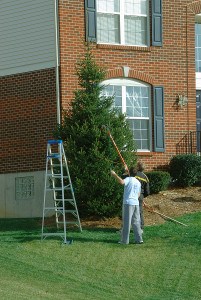As the nation gears up to decorate their homes for the holiday season, the U.S. Consumer Product Safety Commission (CPSC) reminds consumers of decorating dangers and provides tips for a safe holiday. CPSC demonstrated some of the hazards, including Christmas tree and candle fires at its laboratory in Rockville, Maryland.
“Safety should be part of all your decorating efforts,” said CPSC Acting Chairman Ann Marie Buerkle. “Make sure your live Christmas tree has plenty of water, keep lit candles away from flammable items, and use caution when standing on a ladder or a chair to hang decorations.”
Holiday decorating-related injuries:
 CPSC estimates the following holiday decoration-related emergency room-treated injuries nationwide during last year’s holiday season.
CPSC estimates the following holiday decoration-related emergency room-treated injuries nationwide during last year’s holiday season.
- 14,700 holiday decorating related ER-treated injuries. That’s an average of about 240 injuries per day during the holiday season of November and December!
- The most frequent holiday decorating incidents involved falls (41%), lacerations (10%) and back strains (5%).
- Three deaths involving ladder falls.
| Fires involving Christmas Trees and Candles | ||
| Christmas Trees* | Candles** | |
| Fires | 100 | 1200 |
| Deaths | 10 | 10 |
| ER-treated injuries | 20 | 130 |
| Property Loss | $15.7 million | $42.2 million |
| Types of injuries | fire & burns | fire & burns |
| *Average annual estimates from 2012 to 2014 entire calendar year.
**Average annual estimates from 2012 to 2014 for the months of November through December. |
||
The CPSC offers safety tips to keep your family safe:
Trees and Decorations
- Buying a live tree? Check for freshness. A fresh tree is green, its needles are hard to pull from branches, and its needles do not break when bent between your fingers. The bottom of a fresh tree is sticky with resin, and when tapped on the ground, the tree should not lose many needles.
- Setting up a tree at home? Place it away from heat sources, such as fireplaces, vents, and radiators. Heated rooms rapidly dry out live trees, be sure to monitor water levels daily and keep the tree stand filled with water. Place the tree out of the way of foot traffic and do not block doorways with the tree.
- Buying an artificial tree? Look for the label: “Fire Resistant.” Although this label does not mean that the tree will not catch fire, the tree is more resistant to catching fire.
- Decorating a tree in homes with small children? Avoid sharp or breakable decorations. Keep trimmings with small removable parts out of the reach of small children who could swallow or inhale small pieces. Avoid trimmings that resemble candy or food that may tempt a child to try to eat them.
Candles
- Keep burning candles within sight. Extinguish all candles before leaving the room.
- Keep candles on a stable, heat-resistant surface where children and pets cannot reach them or knock them over. Place lit candles away from items that can catch fire such as trees, decorations, curtains and furniture.
Lights
- Only use lights tested for safety by a nationally recognized testing laboratory. Lights for both indoor and outdoor usage must meet strict standards that testing laboratories are able to verify.
- Check each set of lights, new or old, for broken or cracked sockets, frayed or bare wires, or loose connections. Throw out damaged sets and do not use electric lights on a metallic tree.
- Check each extension cord to make sure it is rated for the intended use and is in good condition. Do not use cords with cuts or signs of fraying.
- Check outdoor lights for labels showing the lights have been certified for outdoor use and only plug them into a ground-fault circuit interrupter (GFCI)-protected receptacle or a portable GFCI.
Fireplaces
- Use care with “fire salts,” which produce colored flames when thrown onto wood fires. Fire salts contain heavy metals that can cause intense gastrointestinal irritation and vomiting if swallowed. Keep them away from children.
- Do not burn wrapping paper in the fireplace. A flash fire may result because wrappings can ignite suddenly and burn intensely.
Smoke alarms
- CPSC recommends having working smoke alarms on every floor of the home and in every bedroom. The early warning provided by smoke alarms saves lives.
- Test your smoke alarms every month to make sure they are working properly.
- Change batteries in smoke alarms every year.
Source: CPSC
Was this article valuable?
Here are more articles you may enjoy.

 EVs Head for Junkyard as Mechanic Shortage Inflates Repair Costs
EVs Head for Junkyard as Mechanic Shortage Inflates Repair Costs  Harvard Study Again Stirs the Pot on Demotech Ratings of Florida Carriers
Harvard Study Again Stirs the Pot on Demotech Ratings of Florida Carriers  Zurich, Philadelphia, Others Ordered to Pay $345M to Cover Abuse Charges at Georgia School
Zurich, Philadelphia, Others Ordered to Pay $345M to Cover Abuse Charges at Georgia School  California Chiropractor Sentenced to 54 Years for $150M Workers’ Comp Scheme
California Chiropractor Sentenced to 54 Years for $150M Workers’ Comp Scheme 